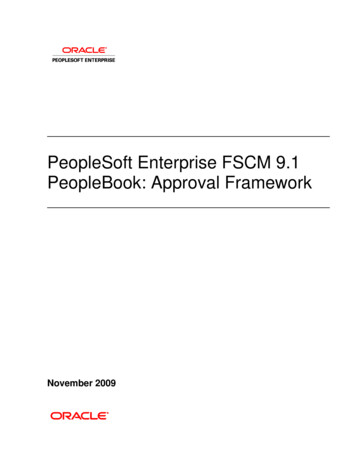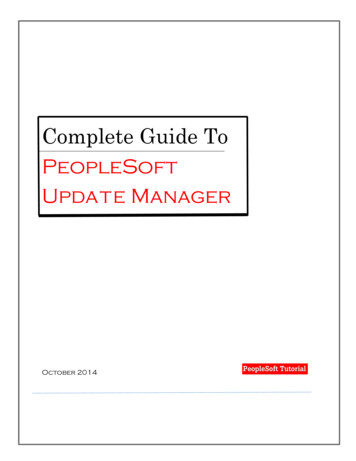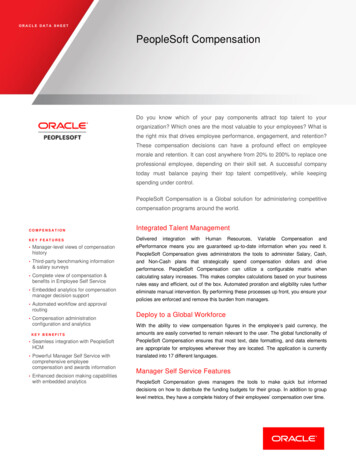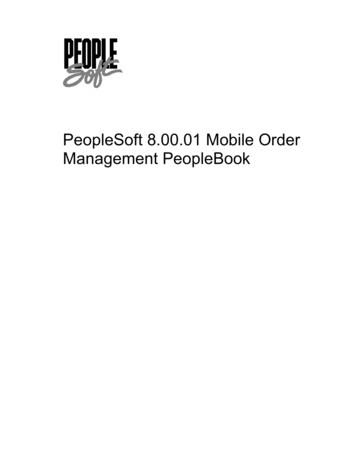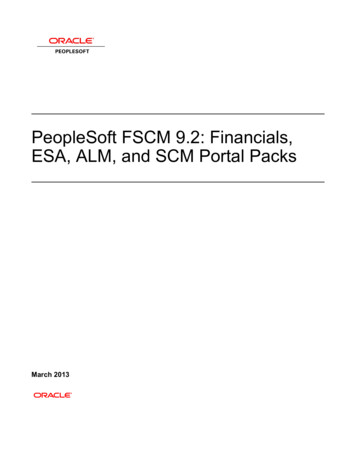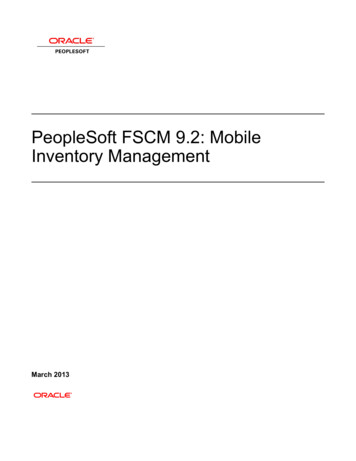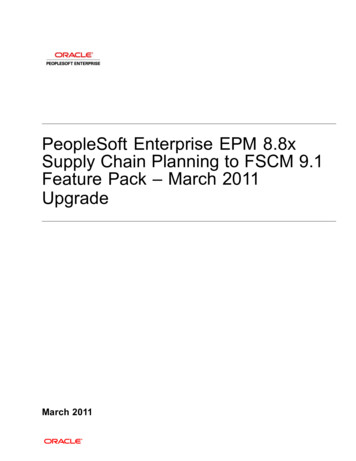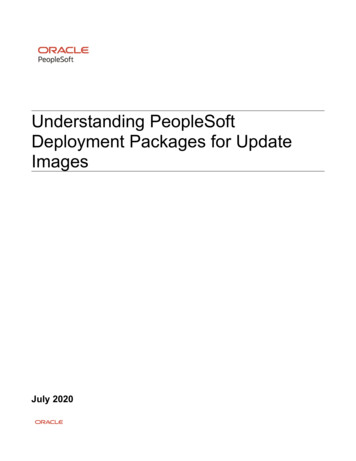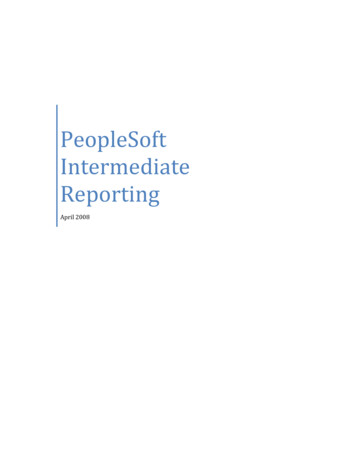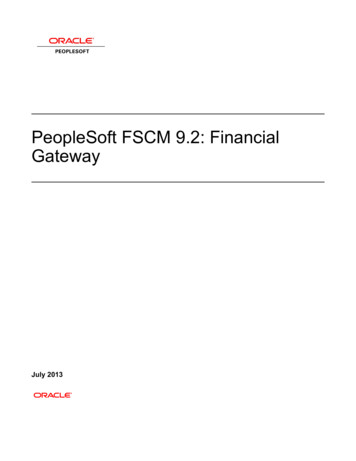
Transcription
PeopleSoft FSCM 9.2: FinancialGatewayJuly 2013
PeopleSoft FSCM 9.2: Financial GatewayCDSKU fscm92pbr1 r03 hosted-docCopyright 1992, 2013, Oracle and/or its affiliates. All rights reserved.Trademark NoticeOracle and Java are registered trademarks of Oracle and/or its affiliates. Other names may be trademarksof their respective owners.Intel and Intel Xeon are trademarks or registered trademarks of Intel Corporation. All SPARC trademarksare used under license and are trademarks or registered trademarks of SPARC International, Inc.AMD, Opteron, the AMD logo, and the AMD Opteron logo are trademarks or registered trademarks ofAdvanced Micro Devices. UNIX is a registered trademark of The Open Group.License Restrictions Warranty/Consequential Damages DisclaimerThis software and related documentation are provided under a license agreement containing restrictionson use and disclosure and are protected by intellectual property laws. Except as expressly permittedin your license agreement or allowed by law, you may not use, copy, reproduce, translate, broadcast,modify, license, transmit, distribute, exhibit, perform, publish, or display any part, in any form, or by anymeans. Reverse engineering, disassembly, or decompilation of this software, unless required by law forinteroperability, is prohibited.Warranty DisclaimerThe information contained herein is subject to change without notice and is not warranted to be error-free.If you find any errors, please report them to us in writing.Restricted Rights NoticeIf this is software or related documentation that is delivered to the U.S. Government or anyone licensing iton behalf of the U.S. Government, the following notice is applicable:U.S. GOVERNMENT END USERS: Oracle programs, including any operating system, integratedsoftware, any programs installed on the hardware, and/or documentation, delivered to U.S. Governmentend users are "commercial computer software" pursuant to the applicable Federal Acquisition Regulationand agency-specific supplemental regulations. As such, use, duplication, disclosure, modification,and adaptation of the programs, including any operating system, integrated software, any programsinstalled on the hardware, and/or documentation, shall be subject to license terms and license restrictionsapplicable to the programs. No other rights are granted to the U.S. Government.Hazardous Applications NoticeThis software or hardware is developed for general use in a variety of information managementapplications. It is not developed or intended for use in any inherently dangerous applications, includingapplications that may create a risk of personal injury. If you use this software or hardware in dangerousapplications, then you shall be responsible to take all appropriate fail-safe, backup, redundancy, andother measures to ensure its safe use. Oracle Corporation and its affiliates disclaim any liability for anydamages caused by use of this software or hardware in dangerous applications.
Third Party Content, Products, and Services DisclaimerThis software or hardware and documentation may provide access to or information on content, products,and services from third parties. Oracle Corporation and its affiliates are not responsible for and expresslydisclaim all warranties of any kind with respect to third-party content, products, and services. OracleCorporation and its affiliates will not be responsible for any loss, costs, or damages incurred due to youraccess to or use of third-party content, products, or services.Alpha and Beta Draft Documentation NoticeIf this document is in preproduction status:This documentation is in preproduction status and is intended for demonstration and preliminary use only.It may not be specific to the hardware on which you are using the software. Oracle Corporation and itsaffiliates are not responsible for and expressly disclaim all warranties of any kind with respect to thisdocumentation and will not be responsible for any loss, costs, or damages incurred due to the use of thisdocumentation.
ContentsPreface.ixUnderstanding the PeopleSoft Online Help and PeopleBooks. ixPeopleSoft Hosted Documentation. ixLocally Installed Help. ixDownloadable PeopleBook PDF Files.ixCommon Help Documentation.ixField and Control Definitions. xTypographical Conventions. xISO Country and Currency Codes. xiRegion and Industry Identifiers. xiAccess to Oracle Support.xiiDocumentation Accessibility.xiiUsing and Managing the PeopleSoft Online Help.xiiPeopleSoft FSCM Related Links. xiiContact Us. xiiiFollow Us.xiiiChapter 1: Getting Started with PeopleSoft Financial Gateway. 15Financial Gateway Business Processes. 15PeopleSoft Financial Gateway Integrations.15PeopleSoft Financial Gateway Implementation. 15Chapter 2: Defining Financial Gateway Integration Options.17Understanding the Financial Gateway Integration Process.17Registering a Source Application with Financial Gateway.19Page Used to Register Source Applications with Financial Gateway. 19Understanding the Registration Process.19Source Registration Page. 19Chapter 3: Setting Up Electronic Banking Using Financial Gateway. 27Understanding Electronic Banking. 27Setting Up Common Components for Bank Statement, Payment, and Payment AcknowledgmentProcessing.35Pages Used to Set Up Common Components for Bank Statement, Payment, and PaymentAcknowledgment Processing.36Components Common to Bank Statement, Payment, and Payment AcknowledgmentProcessing. 36Understanding the Layout Catalog. 37Understanding Code Mapping. 43Understanding File Encryption. 44Layout Catalog Page. 45Code Mappings Page.51Event Code Definition Page.52Setting Up PeopleSoft Integration Broker for Bank Statements, Payments, and PaymentAcknowledgements. 53Pages Used to Set Up PeopleSoft Integration Broker. 56Defining Integration Broker Settings for Payments.57Defining Integration Broker Settings for Bank Statements and Payment Acknowledgments.59Setting Up Bank Statement Processing. 61Pages Used Exclusively for Setting Up Bank Statement Processing. 61Copyright 1992, 2013, Oracle and/or its affiliates. All rights reserved.v
ContentsComponents Used to Set Up Bank Statement Processing. 62Defining Bank Statement Balance Codes. 62Defining Transaction Codes. 63Setting Up Payment Processing.66Pages Used Exclusively for Setting Up Payment Processing.67Payment Grouping Rules Page. 68Bank Integration Layouts Page. 69Creating Payment Layouts. 72External Command Page.74Setting Up Payment Acknowledgment Processing. 75Reviewing Event Log Information. 75Page Used to Review Event Log Information.76Review Event Log Page.76Using a Communications Partner for Electronic Banking. 77Using Remittance Advice in Financial Gateway. 78Pages Used to Send Remittance Advice.78Remittance Advice Attributes Page. 79Advance Payment Notification Page. 79Resend Notification Page. 80Chapter 4: Setting Up Payment Security.83Understanding Payment Security.83Activating Payment Security. 84Page Used to Activate Payment Security. 85Security Options Page. 85Creating Payment Security Rules. 86Page Used to Create Payment Security Rules. 87Security Rules Page.87Assigning Payment Security Rules.87Pages Used to Assign Payment Security Rules. 87Security Role Assignment Page and Security User Assignment Page. 88Chapter 5: Processing Bank Statements in Financial Gateway.89Understanding Statement Updates.89Technical Overview of Bank Statement Data Transmittal.89Prerequisites. 90Common Elements Used in Processing Bank Statements in Financial Gateway.90Importing Bank Statements. 91Pages Used to Import Bank Statements.91Import Bank Statements Page. 91Reviewing Bank Statement Files.94Pages Used to Review Bank Statement Files. 95Review Bank Statement Files Page. 95Chapter 6: Working with Payments in Financial Gateway. 97Understanding the Payment Process in Financial Gateway. 97Importing Payments and Payment Cancellations as Flat Files from Third-Party Applications.104Page Used to Import Payment and Payment Cancellation Flat Files.104Understanding Importing Payments and Payment Cancellations as Flat Files from ThirdParty Applications. 105Import Payment Flat Files Page.105Reviewing the Results of the Payment Load Process. 107Pages Used to Review the Results of the Payment Load Process. 107Review Payment Requests Page. 108viCopyright 1992, 2013, Oracle and/or its affiliates. All rights reserved.
ContentsReviewing and Changing Payments in Financial Gateway.108Pages Used to Review Payments in Financial Gateway.109Understanding Payment Status Changes in Financial Gateway. 109Review Payments - Payments Page. 110Payment Preferences Page. 113Review Payment Details Page. 115Override Payment Status Page.118Dispatching Payments in Financial Gateway. 119Pages Used to Dispatch Payments. 120Payment Dispatch Page.120Reviewing Payment Files. 123Pages Used to Review Payment Files.124Payment Files Page. 124Override Payment File Status Page. 127Importing Bank Acknowledgments. 128Pages Used to Import Bank Acknowledgments. 128Understanding Acknowledgments.128Import Acknowledgement Files Page. 129Review Payments - Acknowledgement Files Page.131Chapter 7: Defining SEPA Requirements and Transactions.133Understanding SEPA.133SEPA Glossary.133SEPA BIC Requirements.135SEPA Credit Transfer and Direct Debit Initiation. 136SEPA Credit Transfer. 138SEPA Direct Debit.139SEPA Payment Cancellations and Reversals. 141Using the EBICS Protocol with SEPA Payments.143Pages Used to Implement EBICS. 150EBICS Information Page.150EBICS Item List Page.152Entering and Managing Direct Debit Mandates.153Pages Used to Enter and Manage Direct Debit Mandates.153Print Direct Debit Mandate Form Page. 154Direct Debit Mandate for Counterparties Page.155Direct Debit Mandate for Customers Page.159Amending a Direct Debit Mandate.161Approve Direct Debit Mandates Page. 162Cancel Direct Debit Mandates Page. 163Cancel Unused Mandates Page. 164Integrating with PeopleSoft Global Payroll. 165Appendix A: Financial Gateway Reports.171Financial Gateway Reports: A to Z.171Copyright 1992, 2013, Oracle and/or its affiliates. All rights reserved.vii
ContentsviiiCopyright 1992, 2013, Oracle and/or its affiliates. All rights reserved.
PrefaceUnderstanding the PeopleSoft Online Help and PeopleBooksThe PeopleSoft Online Help is a website that enables you to view all help content for PeopleSoftApplications and PeopleTools. The help provides standard navigation and full-text searching, as well ascontext-sensitive online help for PeopleSoft users.PeopleSoft Hosted DocumentationYou access the PeopleSoft Online Help on Oracle’s PeopleSoft Hosted Documentation website, whichenables you to access the full help website and context-sensitive help directly from an Oracle hostedserver. The hosted documentation is updated on a regular schedule, ensuring that you have access to themost current documentation. This reduces the need to view separate documentation posts for applicationmaintenance on My Oracle Support, because that documentation is now incorporated into the hostedwebsite content. The Hosted Documentation website is available in English only.Locally Installed HelpIf your organization has firewall restrictions that prevent you from using the Hosted Documentationwebsite, you can install the PeopleSoft Online Help locally. If you install the help locally, you have morecontrol over which documents users can access and you can include links to your organization’s customdocumentation on help pages.In addition, if you locally install the PeopleSoft Online Help, you can use any search engine for fulltext searching. Your installation documentation includes instructions about how to set up Oracle SecureEnterprise Search for full-text searching.See PeopleTools 8.53 Installation for your database platform, “Installing PeopleSoft Online Help.” If youdo not use Secure Enterprise Search, see the documentation for your chosen search engine.Note: Before users can access the search engine on a locally installed help website, you must enable theSearch portlet and link. Click the Help link on any page in the PeopleSoft Online Help for instructions.Downloadable PeopleBook PDF FilesYou can access downloadable PDF versions of the help content in the traditional PeopleBook format.The content in the PeopleBook PDFs is the same as the content in the PeopleSoft Online Help, but it hasa different structure and it does not include the interactive navigation features that are available in theonline help.Common Help DocumentationCommon help documentation contains information that applies to multiple applications. The two maintypes of common help are: Application FundamentalsCopyright 1992, 2013, Oracle and/or its affiliates. All rights reserved.ix
Preface Using PeopleSoft ApplicationsMost product lines provide a set of application fundamentals help topics that discuss essential informationabout the setup and design of your system. This information applies to many or all applications in thePeopleSoft product line. Whether you are implementing a single application, some combination ofapplications within the product line, or the entire product line, you should be familiar with the contentsof the appropriate application fundamentals help. They provide the starting points for fundamentalimplementation tasks.In addition, the PeopleTools: PeopleSoft Applications User's Guide introduces you to the variouselements of the PeopleSoft Pure Internet Architecture. It also explains how to use the navigationalhierarchy, components, and pages to perform basic functions as you navigate through the system. Whileyour application or implementation may differ, the topics in this user’s guide provide general informationabout using PeopleSoft Applications.Field and Control DefinitionsPeopleSoft documentation includes definitions for most fields and controls that appear on applicationpages. These definitions describe how to use a field or control, where populated values come from, theeffects of selecting certain values, and so on. If a field or control is not defined, then it either requiresno additional explanation or is documented in a common elements section earlier in the documentation.For example, the Date field rarely requires additional explanation and may not be defined in thedocumentation for some pages.Typographical ConventionsThe following table describes the typographical conventions that are used in the online help.Typographical ConventionDescriptionBoldHighlights PeopleCode function names, business functionnames, event names, system function names, method names,language constructs, and PeopleCode reserved words that mustbe included literally in the function call.ItalicsHighlights field values, emphasis, and PeopleSoft or otherbook-length publication titles. In PeopleCode syntax, italicitems are placeholders for arguments that your program mustsupply.Italics also highlight references to words or letters, as in thefollowing example: Enter the letter O.xKey KeyIndicates a key combination action. For example, a plus sign ( ) between keys means that you must hold down the first keywhile you press the second key. For Alt W, hold down the Altkey while you press the W key.Monospace fontHighlights a PeopleCode program or other code example. . . (ellipses)Indicate that the preceding item or series can be repeated anynumber of times in PeopleCode syntax.Copyright 1992, 2013, Oracle and/or its affiliates. All rights reserved.
PrefaceTypographical ConventionDescription{ } (curly braces)Indicate a choice between two options in PeopleCode syntax.Options are separated by a pipe ( ).[ ] (square brackets)Indicate optional items in PeopleCode syntax.& (ampersand)When placed before a parameter in PeopleCode syntax,an ampersand indicates that the parameter is an alreadyinstantiated object.Ampersands also precede all PeopleCode variables. This continuation character has been inserted at the end of aline of code that has been wrapped at the page margin. Thecode should be viewed or entered as a single, continuous lineof code without the continuation character.ISO Country and Currency CodesPeopleSoft Online Help topics use International Organization for Standardization (ISO) country andcurrency codes to identify country-specific information and monetary amounts.ISO country codes may appear as country identifiers, and ISO currency codes may appear as currencyidentifiers in your PeopleSoft documentation. Reference to an ISO country code in your documentationdoes not imply that your application includes every ISO country code. The following example is acountry-specific heading: "(FRA) Hiring an Employee."The PeopleSoft Currency Code table (CURRENCY CD TBL) contains sample currency code data. TheCurrency Code table is based on ISO Standard 4217, "Codes for the representation of currencies," andalso relies on ISO country codes in the Country table (COUNTRY TBL). The navigation to the pageswhere you maintain currency code and country information depends on which PeopleSoft applicationsyou are using. To access the pages for maintaining the Currency Code and Country tables, consult theonline help for your applications for more information.Region and Industry IdentifiersInformation that applies only to a specific region or industry is preceded by a standard identifier inparentheses. This identifier typically appears at the beginning of a section heading, but it may also appearat the beginning of a note or other text.Example of a region-specific heading: "(Latin America) Setting Up Depreciation"Region IdentifiersRegions are identified by the region name. The following region identifiers may appear in the PeopleSoftOnline Help: Asia Pacific Europe Latin Am
Understanding the PeopleSoft Online Help and PeopleBooks The PeopleSoft Online Help is a website that enables you to view all help content for PeopleSoft Applications and PeopleTools. The help provides standard navigation and full-text searching, as well as context-sensitive online help for PeopleSoft users. PeopleSoft Hosted Documentation
